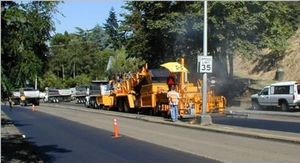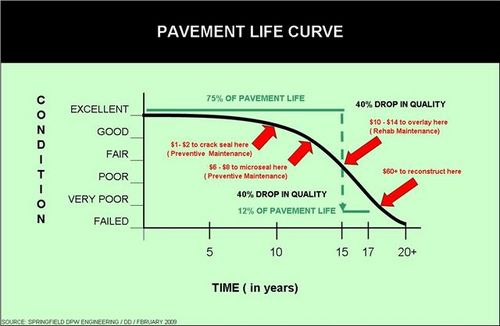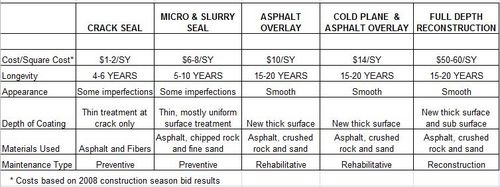
The replacement cost of the City of Springfield 450 miles of roadway would cost over $500 million. This makes our streets one of our most expensive assets. Pavement management is a way of protecting this investment, therefore maximizing the life of our streets and getting you the most for your tax dollar.
Why is Pavement Management important?
When it comes to moving people and materials in Springfield, the streets are our most vital asset. It would cost over $50 million to replace the surface of our more than 120 miles of arterial and 330 miles of residential streets. We believe an investment this important should be carefully preserved and maintained for our residents. Springfield’s Pavement Management Program does just that.
The Pavement Management Program seeks to balance preservation with replacement of existing surfaces. The most cost-efficient way to correct any street surface problem is to address issues when they first appear. That is why funds are targeted at streets rated in fair-to-good condition. Without this preventive maintenance, these streets would quickly deteriorate and be much more costly to fix. Asphalt that was $29/ton in 2003 has increased to over $65/ ton in 2008.
The “pavement life curve,” shown below, illustrates this point. Pavement may appear to be in good condition for a long time. However, when it fails, it fails quickly and repair costs increase dramatically. Preventative maintenance, such as crack sealing, slurry seals, pavement cut restoration extends the life of our valuable street system. In addition to lowering costs over time, other advantages of our Pavement Management Program include: more predictable funding needs, fewer premature pavement failures, safer road conditions and reduced time spent in traffic due to construction.

How do you do Pavement Management?
Although a complete annual inspection of all of Springfield’s streets to document their existing condition is not practical, a percentage is inspected annually. Main (arterial) streets with heavy traffic and associated wear and tear are inspected more frequently than local (residential) streets with much lower wear and tear. With this information, the city chooses roads needing preventive maintenance, resurfacing or reconstruction.
After roads are inspected, a condition index is calculated from 0-100. Generally, streets rated 70-100 are considered “good.” One of our goals is to keep “good” streets in “good” condition. When roads begin to fail, they fail quickly and the costs to repair them increases dramatically. While it might be tempting to fix “failed” streets first, it would be so expensive no money would be left for preventive maintenance or rehabilitation of “fair” to “good” streets.
One major consideration is to coordinate needed pavement resurfacing with other street, water, sewer and underground utility improvements. Streets included in the annual maintenance program are carefully-selected based on engineering evaluations, and input from citizens and maintenance personnel. After all factors have been considered, the candidates are reviewed and a final project list is developed.
Street opening permits for utilities such as water, sewer, cable, phone, electricity and gas are another part of the pavement management program. Street openings penetrate the pavement and lead to accelerated asphalt deterioration. This permitting process seeks to minimize the excavation of newly maintained roads through effective ongoing coordination; and ensuring that experienced, licensed contractors put the pavement back to original conditions and guarantee their work for 12 months. Their permit fees also fund city pavement repair activities.
What types of resurfacing options are available?
Crack sealing: a hot tar liquid applied to surface cracks to seal the pavement from water penetrating under the surface.
Micro surfacing: a mixture of fine rock, asphalt & water placed on the pavement about ¼-inch thick to protect the surface from sun & rain.
Overlays: a mixture of coarse rock & asphalt two inches or more in depth to provide additional load carrying capacity & a smoother ride.
Coldplane Overlays: grinding off a two or more inch layer of existing pavement and then applying an overlay.
Full Depth Deconstruction: Pulverize or remove the existing pavement, regrade and recompact the remaining materials followed by multiple asphalt overlays.
What are the costs of resurfacing options?

How much has Springfield spent on paving annually?
The majority of funding for Springfield’s paving program comes from the Massachusetts Highway Department (MHD) Chapter 90 program. These funds are from the Commonwealth’s Transportation Bond Bill and are allocated to all 351 Massachusetts communities via a complex formula with accepted public street miles being a key factor.
The City initiated a program in 2007 to legally accept “private ways” as “public streets” so long as they meet City standards to increase our Chapter 90 paving funding from MHD. Springfield had over 80 miles of private ways in 2006. The DPW Engineering Division has spearheaded this effort that has resulted in 25% of the private ways being converted to public streets. Additionally, Springfield has bonded for over $650,000 for private way paving since 2007 to assist increasing our Chapter 90 mileage.
The Chapter 90 funding has ranged from $0.9 to 2.9 million since 1996, and from $1.8 to 2.7 million since 2003. This variability and the recent escalation of asphalt prices (over a 100% increase per ton since 2003) make consistent construction goals per year difficult. MHD allows communities to use the Chapter 90 funds for any pavement management activity to include truck and heavy equipment purchase, with some using over 50 % for non-paving projects. Springfield dedicates over 85% of our Chapter 90 funding to road paving projects in order to preserve our $500 million asset- the 450 miles of City streets.
The three most common types of resurfacing treatments are crack sealing, asphalt overlay and cold plane and overlay. These treatments both extend the life of the roadway and replace the street surface. All may look similar but, as the Pavement Life Curve chart above shows, offer distinct cost differences that can be targeted to specific street needs. Through our Pavement Management Program, we can choose the best method for protecting our transportation needs and maximizing the benefits from limited paving funds.